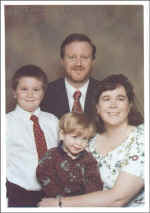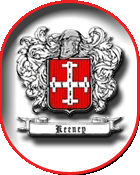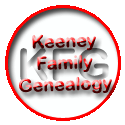

By: Bill Allen Keeney

Co.,
Cork, Ireland
Updated on 25 August 1998 for use on this site.
Bill & Carol & Phillip & Conner
Introduction
There has been much work done in the pursuit of genealogy and family history related to the Keeney surname in America. My interests have, partly because of this fact, been focused on the Keeney surname origins prior to Keeneys arriving in America. Many straight forward questions could be asked like: Who was the first person to have the "Keeney" surname?. Where did he live? What was his life like? First, it would seem reasonable to resolve the question, from which culture does the Keeney surname originate? Much has been suggested, Irish, Scottish, Anglo-Saxon.
The work done so far
Since I can remember, my immediate family has always talked about our Irish / Scottish origins. My earliest definitively traceable Keeney ancestors date back to the 1750’s in the Greenbrier County, West Virginia area. Not being happy with any ambiguity, I wanted to be sure of the racial origins of the Keeney surname. I began, of course, by reading the family history compiled by my Great Aunt Georgia Keeney in the 1950’s and the more comprehensive work done by Roscoe Keeney. Both of these works suggest Irish as the most probable origin, but also mention Scottish and Anglo-Saxon as well. In addition, I wrote several genealogical societies in England, Ireland, and Scotland and procured names and addresses of Keeneys living inside and outside the United States today. I have also found world wide census and telephone directories, giving a clear picture of the immigration of Keeney ancestors. There was only one Keeney I could find listed in mainland Europe, but quite a few showed up in Ireland, Scotland, England, the United States, Canada, New Zealand and Australia. This global distribution is very characteristic of the immigrations of people from Ireland. The United States has by far the largest population of Keeneys, estimated in the 15 to 20,000 range. I received quite a number of responses from the governmental and private genealogical societies in the British Isles and all of them stated the origin as Irish. One response I received was quite definitive from the National Library of Ireland, with records dating to the 1500’s, stating that the Keeney surname is of Irish Gaelic origin. Indeed, the "eeney" ending is quite common in Irish Gaelic surnames (Deeney, Feeney, Heeney, and Sweeney are all commonly known to be of Irish Gaelic origin). James Heeney is the composer of the Republic of Ireland’s National Anthem. Note that there are actually four main categories of Irish surnames, Irish Gaelic (the native Celtic Irish people), Norman Irish (like the Fitzgeralds and Burkes, from de Burge), English Irish, and Scots Irish (generally people of Anglo-Saxon descent from lowland Scotland who came to the northern province of Ulster in the 1600 and 1700’s during the "plantation" period). The Library of Ireland also provided the Gaelic spelling as Ó Cianaigh (pronounced O Keeney). They also indicated that the surname originated in the northwest of Ireland in the counties of Donegal and Galway. I found, through the census and telephone records a few Keeneys living in Galway, but by far the greatest number of Keeneys living in Ireland today are in County Donegal. As a matter of fact, I found most counties in Ireland void of "Keeneys" with almost all living in the northwest counties of Ireland. I was, prior to the original publishing of this research, in correspondence with several Keeney families in County Donegal, Ireland. Since the original article, I have traveled to Ireland on two occasions and spent a considerable amount of time with a number Keeney families there. The Keeneys there have indicated a strong Irish Gaelic tradition in the family that dates back countless generations. Of course, I have also spent a lot of time studying Irish, Scottish, and English history as well as attended Irish Gaelic language courses.
I currently attend a weekly Irish Gaelic conversational exercise. Irish is the second official language of the Republic of Ireland and the primary language in the Gaelic speaking areas known as Gaeltachts. These regions are government sponsored to support traditional language and culture where the everyday language of home, business and education is the native Irish Gaelic. Through all these studies I have started putting a picture together of what life was like for our earliest Keeney ancestors and what things motivated their immigration, up until the present day immigrants.
Notes on Irish surnames and culture
The Irish Celtic culture dates back to before 300 BC and is one of the first cultures to have a system of patrinomical surnames. The names usually indicated a place of origin or a trade and were passed down from generation to generation, particularly, since the family, or "clann" in the Irish language, was the most important political unit. Clann, is the Gaelic word for children and is used interchangeably when discussing one’s family (the origin of the word "clan" as we use it today). One’s genealogy being particularly important since it implied certain rights under "Brehon Law" (the Celtic legal code) and also indicated inheritance of property and degree of political influence. During most of Irish history the people functioned inside tribal units, with chieftains and sub-chieftains and their families controlling areas of land and feuding from time to time with other "clans" over land and possessions, especially livestock, the currency of the day. My own name in Gaelic is Liam (William), grandson of Cianch (Kenneth). Actually I have traced the Cianch name as "sad or sorrowful" and could have actually implied a person who sang sorrowfully or "lamanted" as a trade at the community gravesides, along the same lines as the bag piper in the movie "Braveheart". Today, in Ireland, a person who laments at the graveside is known as a "Keener". I would have chosen to use this a based on the genealogy which would have been of the most benefit to me. Had I actually been the son of Cianch, I could be known as Liam Mac Cianaigh. Contrary to popular belief, Mac is not a Scottish prefix. It was simply more common to attach the Mac prefix when people anglicized their names in Scotland. I’ll discuss the close ties between the Irish and Scottish cultures later in this article. The Ó prefix literally means "grandson of" and Mac (the Gaelic word for son) literally means "son of" when preceding the name of your ancestor. My sons could be known as Mac Liam or Ó Cianaigh. One could claim relations up to five generations removed. Indeed, when referring to relations (as in cousins), one could refer to them in the same way. For example, when introducing a cousin in Gaelic, one would say: "Seo col ceather dom, Liam Ó Cianaigh". Meaning, "This is my relation, four times removed, Liam, grandson of Cianch". "Col" meaning "degree of kinship" and "ceather" being the Gaelic word "four". Feminine names are different from male surnames. For example, if I had a daughter, her name might be Máire Ní Chianaigh ( pronounced: "Maweera Nee Heeney", roll yours "R"s in Gaelic). Literally Mary, daughter of the grandson of Cianch. My wife’s name, on the other hand, would be Caral Uí Chianaigh (Carol Eee Heeney) , meaning, Carol wife of the grandson of Cianch. Other variations for say, the Mahoney surname, would be, Mac Mathuna (Mack Mahuna) "son of" , Nic Mhathuna (Nick Vahuna) "daughter of" , Mhic Mhathuna (Vic Vahuna) "wife of".
Notes on Language and Anglicization
The Gaelic (Celtic) Irish, Gaelic Scottish, and Celtic Welsh cultures all experienced the oppressive policy of anglicization. These Celtic cultures were thought of as backward and paganistic and the English government repeatedly outlawed various customs from the 1100’s to the 1800’s. The Irish and Scots were Christianized by Saints Patrick and Columba in the 400’s AD and the Welsh even earlier by influence of the Roman occupation of Britain. The Celtic people in the British Isles were actually considered an "inferior race" and this bigotry has in one form or another propagated until modern times. Penal Laws even went so far as to outlaw the native languages.
The feeling was that this policy would suppress nationalism on the part of these regions and also dilute the possibility of rebellion. Actually, as result of the political and economic pressure on the Gaelic peoples of Ireland and Scotland, the once single language diverged in the 1700’s, making Scottish and Irish different enough in pronunciation and form to be considered distinct languages. Of course, one side effect of this cultural suppression being that the patrinomical surname system broke down. So, contrary again to popular belief, the Anglicized form "Keeney" and other variations in spelling would have appeared prior to immigration to America. It’s easy to see how so many forms of spelling occurred as English administrators took the liberty in spelling names during times of census and tax collection. Other variations I have discovered (still pronounced Keeney) include: Keaney, Keenie, Keeny, and Keanie. One might even imagine the anglicized "Heeney" name having come from Keeney, as a native Irish girl pronounced her name in Gaelic. The surname spellings "Keene" and "Keane" have a silent "e" on the end and are generally considerdced to be of Scottish Gaelic origin. Today, in Ireland , people would use either the English or Irish spelling dependant on the language they are communicating in.
Some historical perspective
The Celtic people originally came from a region north of the
Caucasus Mountains of Asia.
Over hundreds of years they migrated across Europe to eventually be the
dominant culture there when Rome was only a city state. They carried
their traditions and language as far as Scotland and Ireland. Later
these peoples would be called Picts and Gaels and would have related
but distinct languages. Other Celtic languages in Britain, now for
the most part extinct, would be Manx and Cornish. Also, for
reference, the "Briton’s", would be the proper term for the Celtic
peoples who inhabited England prior to and during the Roman
occupation through about 200 AD. It was during the Roman period that
native Irish chieftains of the Del Raida tribe living along the
northern coast of Ireland established kingdoms of their own along
the west coast of Scotland. It was the marriage of a Scottish Prince
and Pictish Princess that brought about what would be known as
Scotland. (the Picts were the Celtic peoples in Scotland during the
Roman times) After this time, the Germanic Angles and Saxons
migrated to England and lowland Scotland, and of course later the
Norse Vikings (700’s) and eventually came the Norman invasion
(descendants of the Norse) of England in 1088. Though England and
lowland Scotland were heavily influenced by the influx of these
peoples, Ireland and the highlands of Scotland remained mostly
Gaelic even into the 1800’s. In Ireland, the Norse were defeated in
1014 at the Battle of Clontarf and thereafter assimilated into the
Gaelic culture. The Norman’s arrived in Ireland in 1167 at the
request of Dermot Mac Murrough to help restore him to the throne of
the province of Leinster (the eastern area of Ireland around
Dublin). Even the Normans were unable to effectively penetrate
outside "The Pale", the area immediately around Dublin and it wasn’t
until the 1700’s that the native Irish chieftains and feudal lords
ultimately lost their political hold. It was during this time that
plantation policy was most rigorously pursued, particularly in the
northern province of Ulster. During the famine times of the 1840’s
the Gaelic speaking people suffered the most, more than 1 million
perished and another 2 million immigrated. The effects of famine can
still be seen today in as the 1840 census showed more than 8 million
inhabitants in Ireland, today the population is still only just over
4 million. With all this though, the Irish have tenaciously held
onto their roots. Monoglots (Gaelic only speakers) could still be
found in remote areas into the 20th century. When in 1922 the Irish
Free State (today known as the Republic of Ireland) was born as a
separate nation from Great Britain, the Irish government set about
repairing the damage done to the traditional culture. Today the
language is taught as a compulsory subject, and indeed other aspects
such as music and traditional dance have been popularized through
such public performances as "River Dance".
What this all means to the Keeneys in America
One can piece together a plausible set of events which lead to the first and subsequent immigration of the Keeneys from Ireland. Let us imagine that the Ó Cianaighs and other Keeney ancestors have been living primarily in the northwest part of Ireland for countless generations. They speak the native Gaelic tongue and are enlightened by the Christian influences. Some travel as seasonal laborers to the Gaelic speaking coastal highlands of Scotland. They farm, they fought when required by their Chieftain landlords and sang their native songs until eventually the English take over the local centers of power (castles, towns) after which the Keeneys become (in effect) British subjects. They report to English administrators for census and tax collection and their names are recorded in the English language and they would indeed, by necessity learn some English. Later the policy of plantation (as early as 1607) takes effect and some of the Keeneys would lose their lands as they are forcefully removed while lowland Scots are brought in as tenants. Eventually, for some the political and economic discrimination becomes enough that the promises and remoteness of the American colonies are appealing. Land there is practically free in the frontier areas as intended by the English to entice Irish, German and Scottish immigrants to be a buffer between the settlements along the coast and the native Indians farther inland. These Keeney "frontier settlers" would be my earliest traceable ancestors as well as the ancestors of many other Keeneys living in America today. Other Keeneys would find work in England and still others during famine times would have left Ireland for Australia, Canada, and New Zealand.
As a popular Irish ballad goes:
| "To live poor I could not endure, as others of my station, |
|
to Merikay (America) I sailed away, and left this Irish nation" |
|
~ The Ramblin Irishman ~ |
In Conclusion
Ultimately, the importance of all this is realizing the effect this history has on our own individual circumstances. Many of us were born in America because our ancestors immigrated here due to their own extreme difficulties. I remember touring in Ireland at an immigration point in County Donegal and suddenly becoming aware of the feelings our ancestors must have felt leaving their home. I'm sure it was a mixture of sadness and anticipation. They probably could not conceive of the effect their decision would have on so many in future generations.
This has helped me realize the importance of my own decisions much more keenly. I would be very interested in any feedback and additional information on Keeney history up to and including immigration. How many Keeneys out there are descended from famine immigrants, etc. My goal is of course to record as much for future generations as possible. There is so much pressure coming from modern society that is destructive to the traditional family concept. I have found that our mutual heritage is a binding force which can help us keep our families together.
I remember not placing much value on this knowledge when I was younger but since having two sons of my own to carry on the name to future generations, it has become of much greater significance. Today, we can take pride in being American Celts of Irish Gaelic descent and give our children that sense of their own self worth and pride in being part of that family. I hope this gives those interested a greater sense of pride in who they are, and that that pride be passed along to the future generations of Keeneys.
For further reading on Irish and Celtic history see:"The
Course of Irish History"
ISBN # 1-57098-015-2
"The
Twilight Lords"
ISBN# 1-56619-598-5
"The Celts" ISBN # 1-56619-218-8
"The
Atlas of World History"
ISBN # 0-7607-0687-5
(great historical maps for reference)
"The Celts" ISBN # 0-670-86558-3 (great color illustrations of Celtic culture)
If you are interested in Irish Gaelic language:
"Teach
Yourself Irish"
ISBN # 0-84423800-7
* NOTE: links in this document were added by Dan Keeney
I would like to thank Bill for allowing me to post his article on the site. - Dan

The view
from Bill and Carol's kitchen.
or in Irish An tuairim ó Bille agus cistin Carol ar.
Items sent in by Bill & Carol
 |
|
|
|
|
|
 |
|
|
|
|
|
|
|
|
 |
||||||